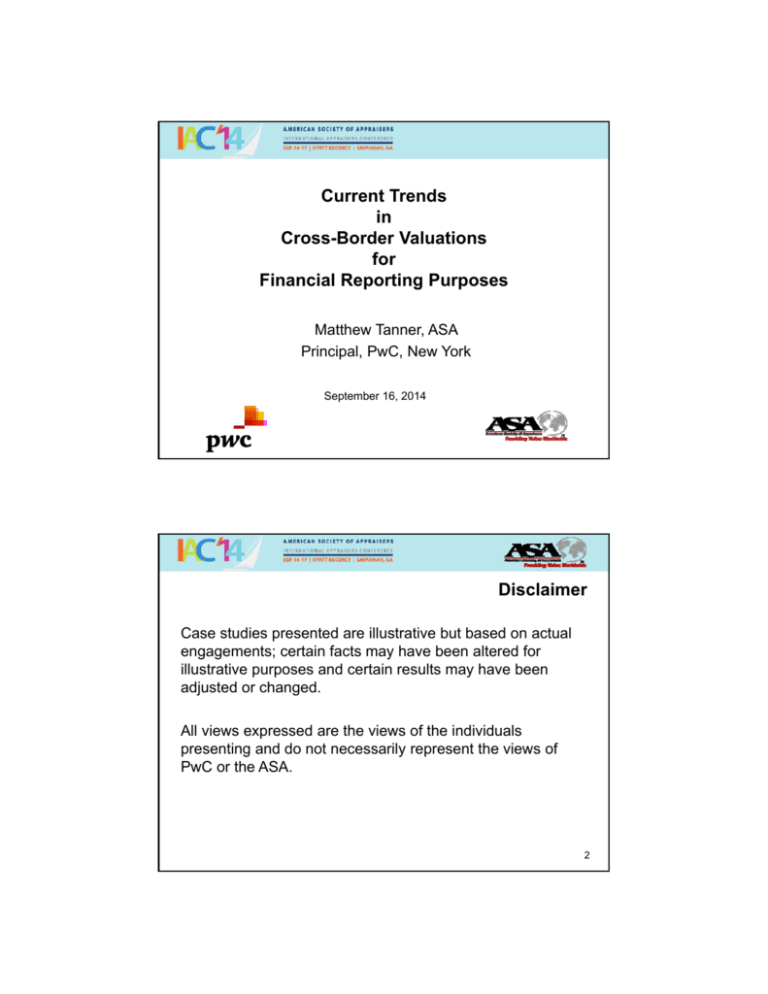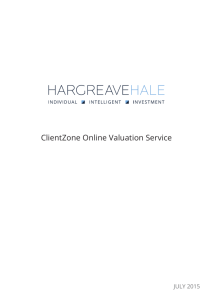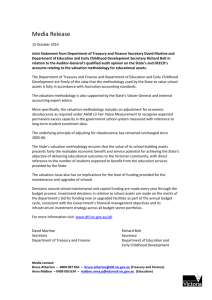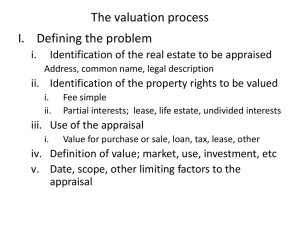
Current Trends
in
Cross-Border Valuations
for
Financial Reporting Purposes
Matthew Tanner, ASA
Principal, PwC, New York
September 16, 2014
Disclaimer
Case studies presented are illustrative but based on actual
engagements; certain facts may have been altered for
illustrative purposes and certain results may have been
adjusted or changed.
All views expressed are the views of the individuals
presenting and do not necessarily represent the views of
PwC or the ASA.
2
Current Trends in Cross-Border Valuations for Financial
Reporting Purposes
Background:
• Trends in financial reporting valuation are always evolving and differ
depending on where in the world the valuation is being performed
• Our clients are global and multinational players
• Therefore, we must be global valuation professionals
• Globalization requires us to be knowledgeable and aware of global trends,
facts and circumstances unique to each country of valuation
• One cannot assume that what works in one country applies globally
• Worldwide markets for sales data are not always readily developed
• Worldwide reporting standards vary too
3
Current Trends in Cross-Border Valuations for Financial
Reporting Purposes
Bottom line:
• Look around the room.
• We have dozens of attendees here at this conference from outside the United
States.
• Before beginning any appraisal, know your:
• Client
• Target
• Industry
• Geography
• Stakeholders
• Auditors
• Cross-border transactions are the new normal.
4
Current Trends in Cross-Border Valuations for Financial
Reporting Purposes
• Today, I will focus my remarks on the following six recently observed topics:
• Determining tangible asset valuation scope and differences noted in
approach on setting the scope of assets to be valued;
• Treatment and approach in dealing with foreign currencies in tangible
asset valuation analyses;
• Increased global data sources and the availability of market, trend, and
other valuation data;
• Trending method versus direct replacement costs;
• Economic obsolescence; and
• Audit reviews and responding to increased Regulator scrutiny.
5
1. Determining Valuation Scope
Differences in Approach
Common approaches on Scope
• Many valuations of multinational companies for financial reporting purposes
include assets located at many facilities, located in many different entities or
countries.
• Recent observations on various scoping methods include:
• Valuing 100% of PP&E or all assets within all facilities/entities/countries;
• Valuing assets at only certain facilities/entities/countries;
• Valuing only certain types or classes of assets only (i.e., only machinery);
and
• Extrapolating results or leaving certain assets not re-valued.
6
1. Determining Valuation Scope
Differences in Approach
Common approaches on Scope (continued)
• Discussions should be held with Management and their auditors prior to
starting any work to ensure that the following are addressed:
• Scope is appropriate given the size of the acquisition
• Materiality of PP&E assets
• Types of assets to be valued
• Approaches
• Methodologies
• Data availability
• Timing
• Review Planning
• Deliverables
7
1. Determining Valuation Scope (continued)
Differences in Approach
Pros and cons of “extrapolating” valuation results across non-valued
assets
• Pros:
• Satisfies certain requirements that 100% of all assets be analyzed
• Can result in Fair Value measurement more in line with “actual” value
• May address general trends to yield ‘representative’ value, even if not
exact
• Cons:
• Risk of overstatement or understatement of Fair Value
• Can result in skewed results unless sample size matches extrapolation set
• May have more or less relevance with specific asset classes or asset types
8
1. Determining Valuation Scope (continued)
Differences in Approach
Case Study and Risks
• Multinational Pharmaceutical Manufacturing Company
• Global PP&E located at 22 facilities in 12 countries
• Top 15 facilities constituted 92% of gross cost basis
• Remaining 7 facilities with 8% of gross cost basis were not valued, but
valuation results were extrapolated over those non-valued assets
• Findings:
• The average age of the valued assets was not congruent to the average
age of the extrapolated assets, thereby causing an over-valuation risk
• Discussions took place between client, their auditors and the appraiser to
determine best path forward
• Decision reached that the risks of extrapolation outweighed potential
benefit
• USE EXTRAPOLATION WITH CAUTION!!
9
2. Domestic vs. Foreign Assets and Locations
Differences in Treatment and Approach
Common approaches used or observed
• When valuing assets in foreign locations different than the buyer’s reporting
country, there are various approaches to trend the assets and deal with
foreign currencies, including:
- Using local, country-specific, known and reliable trends, if available;
- Using another country’s trends and converting currencies using historical
exchange rates;
- Using another country’s trends with a PPI adjustment factor;
- Simply converting currencies as of the balance sheet or valuation date; or
- Obtaining comparable sales in the home country where the equipment is
based.
10
2. Domestic vs. Foreign Assets and Locations (cont)
Differences in Treatment and Approach
Other Considerations
• When valuing assets in foreign locations, one should keep in mind:
- Source of trends and inflation data;
- Limitations on historical trends or exchange rates (pre-certain years);
- Fluctuations in exchange rates over time;
- Hyperinflation or rapid price change over time;
- Certain countries that require restatement of original cost to consider
inflation;
- Country of equipment origin (where manufactured) vs. where equipment is
deployed and being used; and
- “Industry-specific” vs. “class-specific” vs. “country-specific” data and trends
11
3. Increased Global Data Sources
Availability of market, trend, and other valuation data
Key Themes
• Availability of market, trend and other valuation data varies by country.
• The U.S. and EU have been tracking trends in many industries for many years
• Bureau of Labor Statistics (publicly available)
• Marshall Valuation Services (subscription)
• Eurostat (international publicly available)
• More data is becoming available in many countries on an annual basis.
12
3. Increased Global Data Sources
Availability of market, trend, and other valuation data
Key Themes (continued)
• Appraisers should consider adjustments when relying on valuation data from
other countries, if needed.
• There are considerable risks in relying on one country’s data and making the
“assumption” that it is a global marketplace for a certain type of equipment
and therefore equipment behaves similarly in every country or part of the
world.
13
3. Increased Global Data Sources (continued)
Availability of market, trend, and other valuation data
Case Study and Risks
• Multinational Textile Company with operations in US, Europe and China.
• Key issues identified:
• Appraiser did not consider unique China import duties and taxes;
• Market data utilized was assumed to be homogeneous;
• Appraiser did not consider the strength of the Asian textile market relative
to the North American market; and
• Appraiser simply assumed a ‘global’ market and used one trend against all
assets worldwide.
• Overall, important and unique international factors were not considered in
the valuation
14
4. Trending Method vs. Direct Replacement Costs
Pressures resulting in increased trending
Key Themes
• When using the cost approach to value PP&E assets, many appraisers default to
the indirect cost approach (i.e., trending historical costs to estimate reproduction
cost new) without any additional support or confirmation.
• This can be caused by many factors:
• Difficulty in obtaining replacement cost estimates
• Difficulty estimating installation or soft cost percentages
• Scope or fee limitations between Appraiser and Client
• Timing pressures levied by Client
15
4. Trending Method vs. Direct Replacement Costs
Pressures resulting in increased trending
Key Themes (continued)
• Compounding this issue, many Appraisers do not seem to fully consider:
• Functional Obsolescence; or
• Economic Obsolescence.
• Replacement Cost New Less Depreciation does not equal Fair Value
16
4. Trending Method vs. Direct Replacement Costs (cont)
Pressures resulting in increased trending
Unique Concerns
• Issues with using only the indirect (trending) cost approach may include:
• Construction materials may no longer be available resulting in a
significant change in price of equipment;
• Consideration is not given to functional obsolescence including factors
such as:
•
technological advances
• changes in the price and/or type of equipment utilized
• other potential forms of excess capital costs;
17
4. Trending Method vs. Direct Replacement Costs (cont)
Pressures resulting in increased trending
Unique Concerns (continued)
• Applicability of trend for assets purchased many years ago; and
• Issues with currency fluctuation resulting in unreasonable estimates of
reproduction costs.
18
4. Trending Method vs. Direct Replacement Costs (cont)
Pressures resulting in increased trending
Case Study and Risks
• Appraiser valued a wireless telecom network relying primarily on the indirect
cost approach, and they did not consider:
• Reduced capital costs for base stations and other equipment;
• Technology changes and capex requirements to upgrade and roll out LTE
or 4G protocols;
• Applicability of trend for assets purchased many years ago;
• Limited remaining economic life for certain assets well below physical
remaining life; and
• Excessive repetitive costs capitalized on the accounting ledger over and
over again, resulting in multiple layers of assets.
• Always try and corroborate indirect with direct method!
19
5. Identification of Economic Obsolescence (“EO”)
Quantification techniques and considerations
Key Themes
• EO is a complicated topic because it is not always clearly identifiable and
cannot always be easily quantified.
• However, the potential results of not properly considering EO can be
significant, including:
•
•
•
•
•
Overstating depreciation expense;
Understating prospective earnings;
Unexpected impairment of PP&E;
Understating of goodwill or creation of false “bargain purchase”; and
Unintended loss when assets are sold.
20
5. Identification of Economic Obsolescence (“EO”)
Quantification techniques and considerations
Unique Concerns
• This is particularly true for companies where PP&E assets are often a
significant portion of the balance sheet, and where impairment testing for longlived assets is often performed at a lower level of reporting.
• Appraisers must work closely with management to assist in identifying EO and
obtaining necessary information to quantify it.
• Properly indentifying and quantifying EO requires consideration of multiple
approaches and sometimes thinking "out of the box" to quantify it.
21
5. Identification of Economic Obsolescence (“EO”)
Quantification techniques and considerations
Unique Concerns
• Consider floor limit of Orderly Liquidation Value or other minimum
consideration
• Is it appropriate to apply a floor ‘in use” value to very old assets when we
know that newer assets drive value in a business?
• Telecom example: Older technology network assets vs. newer capex?
22
5. Identification of Economic Obsolescence (“EO”)
Quantification techniques and considerations
Case Study and Risks
• Global chemical company with 14 plants within 3 reporting units
• Overall and in totality, the company’s Business Enterprise Valuation supports
the results of the Depreciated Replacement Cost New (“DRCN”) approach for
the PP&E.
• However, certain unique existing facts suggest other concerns:
• Margin varies by plant, and by reporting unit;
• When analyzed at a lower level, EO was identified within 1 of 3 reporting
units;
• Upon further analysis, EO was quantified, and the DRCN for those assets
was adjusted down by 23%
• Be sure not to fall below liquidation value floor
• Resulted in a lower overall Fair Value for the PP&E.
23
6. Audit Reviews of Financial Reporting Valuations
Appraiser/Valuer Perspective vs. Auditor Function
Key Themes
• Enhanced financial reporting and accounting scrutiny over the last decade
has led to more interplay between Appraisers and Auditors.
• Auditors (and often their “valuation specialists”) are called upon to act as
subject matter specialists on many audit reviews relating to transactions
and/or impairments.
• When Appraisers from around the globe are involved, the Audit review
function can take on an extra layer of complexity in cross-border transactions
24
6. Audit Reviews of Financial Reporting Valuations
Appraiser/Valuer Perspective vs. Auditor Function
Key Themes (continued)
• IFRS, US GAAP, Local Country GAAP nuances – all must be considered
• Convergence and Differences should be discussed at outset of engagement
• What about IFRS and Componentization (component by component
identification of equipment)?
• Prior Experience does not by itseld satisfy the Audit documentation
requirement
25
6. Audit Reviews of Financial Reporting Valuations (cont)
Appraiser/Valuer Perspective vs. Auditor Function
Unique Concerns
• Regular and frequent communication between Appraiser and Auditor or
Valuation Specialist review can result in:
• Greater awareness of documentation required which helps Appraisers
understand the extent and nature of audit questions;
• Setting proper and agreed-upon valuation scope at the start of every
engagement to avoid scope or valuation pitfalls;
• Open lines of communication to foster greater understanding of
valuation approaches and methodologies and/or data limitations;
26
6. Audit Reviews of Financial Reporting Valuations (cont)
Appraiser/Valuer Perspective vs. Auditor Function
Unique Concerns (continued)
• Regular and frequent communication between Appraiser and Auditor or
Valuation Specialist review can result in:
• Agreed-upon timing and ground rules help to make the audit review
process as smooth and efficient as possible.
• Market Participant vs. Buyer-Specific considerations
• Target’s existing operational plans vs. Buyer’s new integration plans
27
Closing Points Current Trends in Cross-Border Valuations
for Financial Reporting Purposes
• Setting the appropriate valuation scope is of paramount importance.
• Treating foreign vs. domestic assets correctly from the buyer’s perspective
is key.
• Globalization and technology have increased the availability of valuation
data sources, but the complexity and understanding of that data is in
question.
• Engagement pressures result in heavy reliance on the indirect trending
method, but often a direct replacement cost approach will yield a very
different answer.
• Proper identification and treatment of economic obsolescence at the lowest
level possible is essential for proper valuation results.
• Regular and frequent communication between Appraiser and
Auditor/Specialist will result in a successful project and a happy client.
28
Questions? Current Trends in Cross-Border Valuations for
Financial Reporting Purposes
This publication has been prepared for general guidance on matters of interest only, and does
not constitute professional advice. You should not act upon the information contained in this
publication without obtaining specific professional advice. No representation or warranty
(express or implied) is given as to the accuracy or completeness of the information contained
in this publication, and, to the extent permitted by law, PricewaterhouseCoopers LLP, its
members, employees and agents do not accept or assume any liability, responsibility or duty of
care for any consequences of you or anyone else acting, or refraining to act, in reliance on the
information contained in this publication or for any decision based on it.
© 2014 PricewaterhouseCoopers LLP. All rights reserved. In this document, “PwC” refers to
PricewaterhouseCoopers LLP which is a member firm of PricewaterhouseCoopers
International Limited, each member firm of which is a separate legal entity.
.
29









